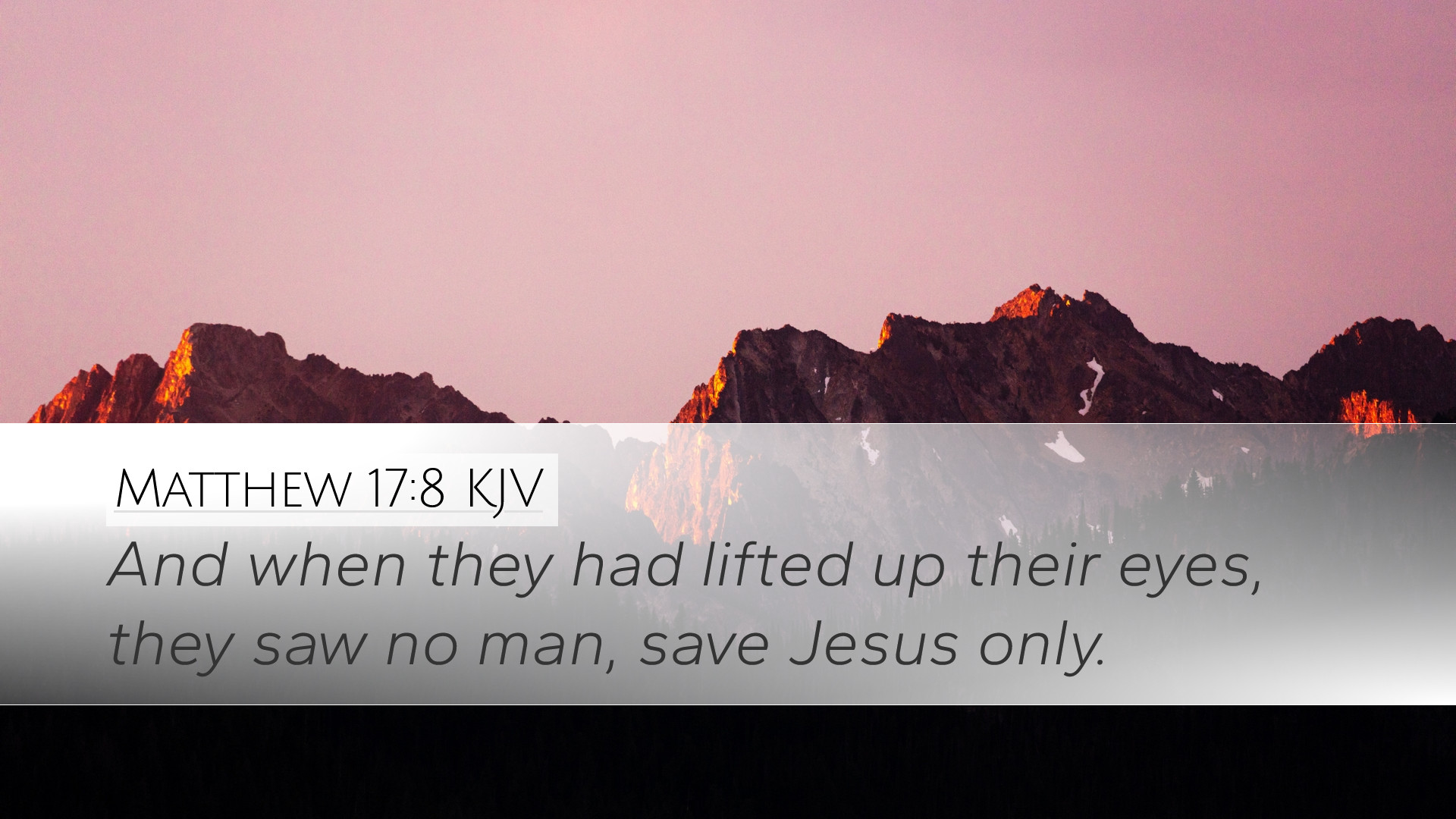Commentary on Matthew 17:8
Verse: "And when they had lifted up their eyes, they saw no man, save Jesus only."
Introduction
This moment in the Gospel of Matthew follows the profound event of the Transfiguration, where Jesus was revealed in divine glory alongside Moses and Elijah. The disciples, Peter, James, and John, have just experienced a revelatory event, and we observe in this verse a poignant transition back to the essence of discipleship: the continuation of their relationship with Jesus alone.
Contextual Analysis
In this passage, the disciples are initially engulfed in awe and fear, grappling with witnessing the radiant glory of Jesus, who stands in unity with the Law (Moses) and the Prophets (Elijah). The abrupt shift to seeing "no man, save Jesus only" is critical and reaffirms the supremacy of Christ in a believer's life.
Matthew Henry's Insight
Matthew Henry emphasizes that the Transfiguration was a foretaste of Christ's glory, meant to strengthen the disciples’ faith. He notes that “they lifted up their eyes,” symbolizing their focus returning to Jesus after the awe-inspiring vision they had just experienced. This action signifies a fundamental Christian principle: the necessity of fixing our eyes upon Christ amidst the distractions and revelations of life.
- The Centrality of Christ: Henry points out that when faced with both the amazing and the frightening aspects of faith, believers are to anchor their vision solely on Jesus. The absence of Moses and Elijah indicates that while past figures in the faith served their purpose, it is Jesus who holds ultimate authority and significance.
- The Transition from Glory to Mission: After their moment of exaltation, the disciples are reminded that the mission must continue with Jesus at the center. The clear separation underscores the necessity of following and relying on Christ above all.
Albert Barnes' Interpretation
Albert Barnes enhances the understanding by affirming that this scene reflects the return to spiritual reality after an extraordinary encounter. He stresses the importance of this transition as an essential teaching for the disciples and all followers of Christ.
- Lessons on Perception: Barnes notes that this passage serves as a reminder to evaluate what we see and hear through the lens of Christ. The disciples were shown that, despite the glorified appearances of others, the essence of their faith journey must remain focused on Christ alone.
- Spiritual Focus: He elaborates on how spiritual experiences, while valuable, should not distract from the reality of Christ’s ongoing ministry and presence. This echoes the necessity of always returning to Christ as the focal point of our lives.
Adam Clarke's Commentary
Adam Clarke’s analysis delves into the implications of seeing "Jesus only." He highlights the importance of recognizing that all spiritual blessing and guidance come from Christ alone. This phrase signifies not only Jesus' exclusivity but also the profundity of His role as the complete revelation of God to humanity.
- Christ's Role in Revelation: Clarke emphasizes that all prior revelations (Moses and Elijah) point inevitably toward Christ. He is the culmination of prophecy and the fulfillment of the law.
- Hope and Assurance: The message of seeing “Jesus only” brings profound hope. In a world filled with distractions, it reassures believers that their salvation, guidance, and strength are found in Jesus alone.
Theological Implications
This verse offers profound theological implications for understanding the nature of Christ in relation to the Church. It underscores the belief that all aspects of Christian faith—including the law, prophets, and even the experiences of the miraculous—must ultimately lead one back to Jesus.
- Superiority of Christ: The statement emphasizes the superiority of Christ over all other religious figures and experiences. Where there was once glory in the Law and the Prophets, the fulfillment and the apex of divine revelation resides solely in Jesus.
- Focus in Discipleship: This passage becomes a directive for discipleship, reminding Christians that their lives should be lived with Christ as their sole focus, underscoring the call to prioritize their relationship with Him above all else.
- Pastoral Application: For pastors and leaders, this serves as a reminder that teaching and guidance should always circle back to Christ, ensuring that congregants understand the preeminence of Jesus in all matters of faith and practice.
Conclusion
Matthew 17:8 is a clarion call for believers to anchor their vision and faith in Jesus Christ alone. In communion with insights from public domain commentaries, it is clear that while spiritual experiences and historic figures play significant roles in the Christian faith, it is Jesus—His life, death, and resurrection—that is the foundation of our walk with God. This truth empowers believers to navigate their spiritual journeys with focus and faithfulness, knowing that all paths ultimately lead back to Him.


